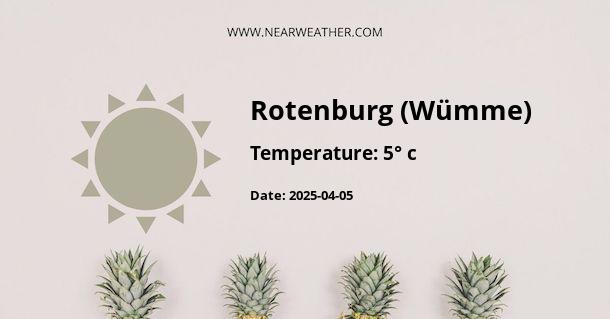Introduction to Landkreis Rotenburg's Climate
Landkreis Rotenburg (Wümme) is a rural district located in the Lower Saxony region of Germany, known for its picturesque landscapes and historic towns. Understanding the climate of this region involves delving into the various meteorological elements that define its seasonal patterns. Landkreis Rotenburg's climate can be classified as a temperate oceanic climate, with influences from the nearby North Sea.
Seasonal Climate Overview of Landkreis Rotenburg
Spring
| Month | Avg. High (°C) | Avg. Low (°C) | Avg. Precipitation (mm) |
|---|---|---|---|
| March | 8.3 | 0.7 | 60 |
| April | 13.1 | 3.3 | 46 |
| May | 18.3 | 7.8 | 57 |
During spring, Landkreis Rotenburg begins to warm up after the cold winter months. Although temperature fluctuations are common, and late frost can occur, the average temperatures steadily rise. Precipitation is moderate but can vary due to occasional frontal systems.
Summer
"Summer in Landkreis Rotenburg is characterized by a mix of warm and comfortable days interspersed with occasional rain showers, which contribute to the lush greenery of the rural landscape." - Local Climatology Expert
- June: The start of summer brings longer days and warmer weather.
- July: Typically the warmest month with the highest chances for heatwaves.
- August: End of summer can bring unpredictable weather, including late-summer storms.
Autumn
- September
- Temperatures begin to decrease, and the early onset of fall weather is noticeable.
- October
- As autumn progresses, leaves change color, and the weather cools further.
- November
- With the approach of winter, temperatures continue to drop, and frost becomes more common.
Winter
The winters in Landkreis Rotenburg are generally cold with a meaningful amount of precipitation, which often falls as snow. Frosts are frequent, and on occasions, heavy snowfall might lead to disruptions. However, temperatures are typically milder compared to more continental regions of Germany.
Climate Data and Weather Patterns
Temperature and Precipitation
Landkreis Rotenburg experiences moderate temperature variations throughout the year. The average annual temperature usually ranges between 1.9°C in the winter and 22.4°C during the height of summer. Precipitation is fairly evenly distributed through the year, with a slight increase in the summer months due to convective rainfalls. The table below summarizes the monthly average temperature and precipitation:
| Month | Avg. High (°C) | Avg. Low (°C) | Avg. Precipitation (mm) |
|---|---|---|---|
| January | 3.5 | -1.7 | 58 |
| February | 4.1 | -1.5 | 42 |
Sunlight and Daylight Hours
The daylight hours in Landkreis Rotenburg fluctuate significantly over the year due to its northern latitude. The longest day occurs at the summer solstice in late June, while the shortest day falls on the winter solstice in late December. This not only affects the climate but also how people plan their activities and energy consumption.
Wind and Weather Systems
Landkreis Rotenburg is affected by both continental and maritime air masses. Winds from the west, coming from the North Sea, tend to bring moisture and mild temperatures. In contrast, easterly winds can lead to drier and colder conditions, especially in the winter. Cyclonic systems from the Atlantic are common, especially in the transitional seasons of spring and autumn, causing variability in the day-to-day weather.
Extreme Weather Events
While extreme weather is less common in Landkreis Rotenburg compared to other parts of the world, it is not immune to such events.
- Thunderstorms: Occur mostly in summer, can lead to heavy rainfall and sometimes hail.
- Snowstorms: Not overly frequent, but snowstorms can occur in winter leading to transportation difficulties.
- Heatwaves: Increasingly common in the recent years, usually occurring in July or August.
- Floods: Rising water levels in rivers and streams can lead to flooding, particularly during the spring thaw or after heavy summer rainfall.
Climate Change Implications
Climate change is a global phenomenon with local consequences. For Landkreis Rotenburg, the implications are manifold:
- Increased average temperatures, leading to longer growing seasons but also potential droughts.
- More frequent heatwaves, challenging the health of vulnerable groups and impacting agriculture.
- Changes in precipitation patterns, with a possible increase in both heavy downpours and dry spells.
- Rising sea levels might not directly affect the inland district, but could have indirect implications for regional weather patterns.
These changes are supported by observations and models predicting climate trends for the coming decades. It's crucial for local authorities, businesses, and residents to adapt to these changes through sustainable practices and planning.
Conclusion
The climate and weather of Landkreis Rotenburg, Germany, showcase the diverse and dynamic character of temperate oceanic climates. It presents a variety of weather conditions year-round, influenced by its geographical positioning, and contributes to the unique charm that the region offers. The district experiences a fairly mild climate, although shifts due to climate change pose future challenges. Overall, understanding these patterns is essential for residents, farmers, and businesses alike who are planning and adapting to the ever-changing climate.
A - Rotenburg (Wümme)'s Latitude is 53.262218 & Longitude is 9.326110.
A - Weather in Rotenburg (Wümme) is 15° today.
A - Climate Conditions in Rotenburg (Wümme) shows overcast clouds today.
A - Humidity in Rotenburg (Wümme) is 59% today.
A - Wind speed in Rotenburg (Wümme) is 11.23 km/h, flowing at 344° wind direction. today.
